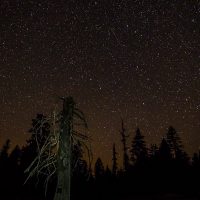This little meadow is is only a couple acres. Along one side is a spring where crisp water seeps from the ground and marks the beginning of a creek. Along the top the last few hundred feet of the paved road ends at a junction of rougher roads that lead further into the forest.

The clearing is surrounded by seventy foot high trees. Pine, fir, and larch are all represented in the dense forest that covers much of the ridgeline. This limits the view, blocking objects low on any horizon. The tall trees also provide a stage above which the stars rise and set, sometimes blinking brightly as they pass behind branches.
There are simply no lights, no substantial civilization for fifty miles in any direction. There are no distant domes of light visible on the horizon to remind one of Edison’s terrible invention. There is just the darkness and the stars above.
I am one who must peer deeper than this. Given a dark sky I appreciate the view, but I want so much more. A dark sky and a telescope is a portal into the vast universe. There are clusters, nebulae,a and galaxies out there, so many in reach of a simple construction of wood, metal, and glass.
I have two telescopes to choose from. On the previous three nights I have used the borrowed 14″, hunting for faint fuzzies beyond the reach of lesser glass. On this night I will choose the little 76mm refractor, despite the lack of aperture it offers low magnification and rich views of thick starfields.
The first task is to polar align the mount for tomorrow’s total solar eclipse. This little scope will also be my photographic platform for the eclipse, tracking would be dramatically improved with even a rough alignment to the Earth’s axis. I carefully shift the mount and crank the latitude screw to align the polar axis.
Polar alignment complete I simply look up at the dark sky, marveling in the beauty of the stars. Familiar constellations map the sky, I mark the turning of hours and seasons in their patterns. I cast about for good targets, where shall I wander this night?
It took me a few moments to identify it. A strange light lanced across the sky, just a flicker, but clearly not natural. Again it came, slower this time, allowing me to recognize a laser beam. The beams converged at a point on the southern horizon. Walking over to a gap in the trees I could see four beams originating there in an obscene green glow on the horizon.
The huge Symbiosis festival is obviously using high power lasers to illuminate the sky. The beams flicker and dance from horizon to horizon. The entire concept is revolting to me, why travel so far from the lights of civilization just to destroy the view with yet more artificial light.
Fortunately I am far enough from the festival to avoid the worst of the effects, the beams merely an annoyance. I continue to hunt clusters through Perseus. I starhop from object to object, sweeping through star fields rich with wonders.
Come 4am the darkness is failing, the faint flush of dawn has arrived. I reluctantly dismount the scope for safe stowage and cover the mount, careful to not disturb the polar alignment. There are a few more hours before the eclipse I could spend on sleep, the event we came for just a few scant hours in the future now. I attempt to sleep I dream of stars and the coming rendezvous of Sun and Moon.

